 by "ttyymmnn" (ttyymmnn)
by "ttyymmnn" (ttyymmnn)
Published 08/01/2017 at 12:35
 by "ttyymmnn" (ttyymmnn)
by "ttyymmnn" (ttyymmnn)
Published 08/01/2017 at 12:35
Tags: Planelopnik
; planelopnik history
STARS: 8
Welcome to This Date in Aviation History , getting you caught up on milestones, important historical events and people in aviation from July 29 through August 1.
!!! UNKNOWN CONTENT TYPE !!!
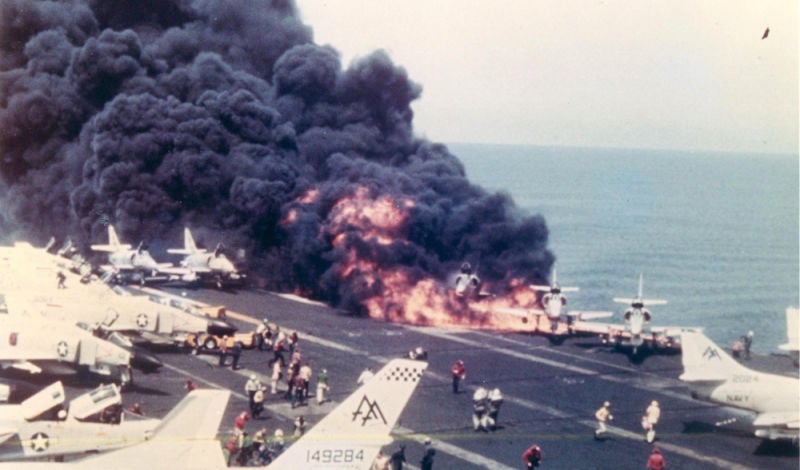
July 29, 1967 – Fire engulfs the flight deck of USS Forrestal off the coast of Vietnam. Working on the flight deck of an aircraft carrier has been called one of the most dangerous jobs in the world. Controlling jet and propeller aircraft around a pitching deck is an intricate ballet of blasting jet engines and spinning propellers, and death or serious injury is a constant concern. And that is just during peacetime. In war, the dangers are compounded by a higher tempo of operations and the presence of bombs, missiles, rockets and fully-fueled aircraft. In fact, the Battle of Midway took a critical turn when American dive bombers arrived while the Japanese aircraft were sitting on deck, fully loaded with bombs and fuel. But despite rigid safety procedures, there is always the potential for disaster. By the early summer of 1967, the war in Vietnam was escalating dramatically, and the carrier USS Forrestal (CVA-59) sailed from Norfolk, Virginia to take up a position at Yankee Station in the Gulf of Tonkin off the coast of Vietnam. Once there, Forrestal immediately began launching attacks against North Vietnam in support of American and South Vietnamese troops. With the pace of operations increasing, the American demand for bombs soon outstripped production, and the Navy was forced to use older ordnance, some of which dated back more than 10 years and had been exposed to the elements wile in storage. On the day preceding the accident, Forrestal received a shipment of 1000-pound bombs, many of which were older, unstable bombs that had been improperly stored in Guam. Forrestal’s commanding officer, Captain John Beling , wanted to refuse the bombs, but he ended up taking them begrudgingly because of the acute shortage of munitions, and the need for the bombs on missions the following day. Forrestal’s bomb handlers were particularly concerned with the unstable bombs being stored belowdecks, where an accidental explosion could sink the entire ship, so the bombs were stored out in the open on the flight deck.
!!! UNKNOWN CONTENT TYPE !!!
Flight deck video cameras captured the conflagration. Early in the video, you can see the pilot of one of the Skyhawks, future US Senator John McCain, barely escaping from his burning aircraft.
At approximately 10:50 am on July 29, an electrical anomaly in a 5-inch Zuni rocket caused it to launch unintentionally from a McDonnell Douglas F-4 Phantom parked on the flight deck. The missile struck the external fuel tank on an armed Douglas A-4 Skyhawk and, while the rocket did not explode, it punctured the fuel tank, and the leaking fuel ignited. As damage control teams rushed to fight the fire, one of the unstable bombs loaded on the Skyhawk detonated, blowing a hole in the armored flight deck, raking the damage control team with shrapnel and covering the deck in burning fuel. As the fires continued to rage, nine more explosions occurred, eight of which were caused by the unstable bombs. The detonations tore holes in the flight deck that allowed burning jet fuel to drain into the living quarters below and into the interior spaces of the ship. The crew worked without heavy equipment to push damaged aircraft into the water and roll bombs over the side. With the aid of the destroyer USS Rupertus (DD-851), which came within 20 feet of Forrestal to use its own fire hoses, Forrestal’s crew was eventually able to extinguish the fire by 4:00 am the next morning. The fire and explosions claimed the life of 134 crewmen, and 161 were injured, many of them seriously. Forrestal returned to Norfolk, where itspent more than 200 days undergoing repairs and refitting before returning to service. Though Capt. Beling was absolved of responsibility for the fire, he was assigned to staff work following the incident and retired in 1973 with the rank of Rear Admiral. Forrestal was decommissioned in 1993. (US Navy photo and video)
!!! UNKNOWN CONTENT TYPE !!!
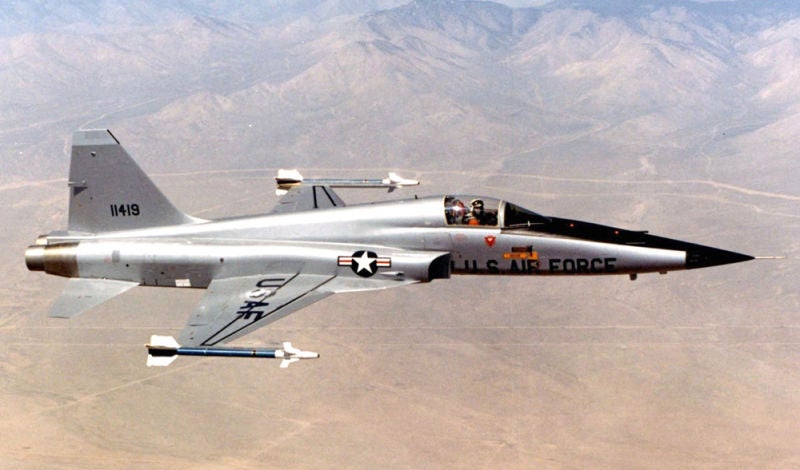
July 30, 1959 – The first flight of the Northrop F-5A Freedom Fighter. When the first jet fighters took flight at the end of WWII, they were relatively simple affairs, essentially straight-winged piston aircraft that were adapted for the new turbojet engines. But as jet engines became more powerful, fighters got bigger, more complex—and more expensive. To combat this trend, Northrop began working on a small, simple fighter in the mid-1950s called the N-156 in the hopes of securing a contract to produce a fighter that could fly from the US Navy’s smaller escort carriers . The design team was led by Northrop’s vice president of engineering Edgar Schmued , who designed two of arguably the greatest fighters ever built, the North American P-51 Mustang and North American F-86 Sabre , before coming to Northrop. Along with chief engineer Welko Gasich, the Northrop team set out with the specific goal of creating a small, low-cost fighter that would be easy to maintain and easy to fly, but would also have the potential for future growth and development. Northrop chose to build their new fighter around two powerful General Electric J85 turbojet engines which were originally designed to power the McDonnell ADM-20 Quail target decoy. Combined with its small size and use of the area rule , which gave the F-5 its characteristic slim waist, the fighter was capable of a top speed of Mach 1.6 with a thrust-to-weight ratio of up to 7.5:1.
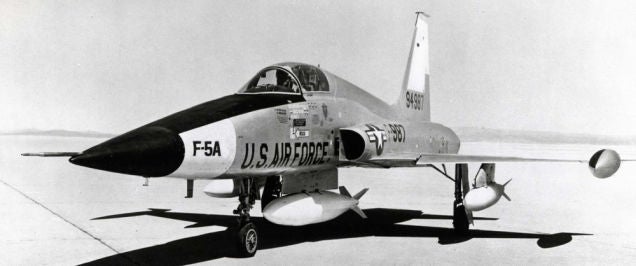
When the Navy decided to retire their remaining escort carriers, Northrop forged ahead with their design, developing both a single-seat fighter version, the N-156F, and a two-seat trainer version, the N-156T. In July 1956, the Air Force chose the two-seat trainer to replace the Lockheed T-33 Shooting Star as its primary trainer, and the newly designated T-38 Talon became the world’s first supersonic trainer, eventually becoming the most-produced trainer to date. Northrop continued developing the N-156F in the hopes of providing a fighter for the Military Assistance Program , which sought to arm nations allied to the US with low-cost weapons, and it was this aircraft which took its first flight on July 30, breaking the sound barrier on its maiden flight. When the US Air Force showed little interest in the F-5, it was ultimately chosen by the Kennedy Administration as the winner of the F-X competition in 1962 to provide a low-cost export fighter. In 1965, the Air Force sent 12 F-5As to Vietnam to evaluate them under the codename Project Skoshi Tiger, and it was here that the F-5 received its unofficial nickname, which became official with the later F-5E/F Tiger II. While the F-5 wasn’t adopted in large numbers by the US, it continues to be flown in the aggressor role for dissimilar combat training, and the Air Force has also bought back some export fighters for use in this role. The Tiger II, which won the International Fighter Aircraft competition in 1970, remains in service alongside older Freedom Fighters the world over. Northrop attempted yet another upgrade to the venerable little fighter with the F-20 Tigershark , hoping to develop an export fighter to compete with the General Dynamics F-16 Fighting Falcon , but it was ultimately unsuccessful. By the end of production in 1987, a total of 847 F-5A/B/C aircraft had been built, along with a total of almost 1,400 F-5E/Fs. (US Air Force photos)
!!! UNKNOWN CONTENT TYPE !!!
!!! UNKNOWN CONTENT TYPE !!!
!!! UNKNOWN CONTENT TYPE !!!

July 29, 1958 – President Dwight Eisenhower signs the National Aeronautics and Space Act, creating NASA. NASA has its origin in the National Advisory Committee for Aeronautics , an agency created in 1915 to further the efforts of aeronautic research and technological development in the United States. But as America entered the space age following WWII, it became clear that the country needed an organization for a new era. The National Aeronautics and Space Act carries this simple preamble: “To provide for research into problems of flight within and outside the earth’s atmosphere, and for other purposes.” While NASA has done, and continues to do, research that carries military implications, its stated purpose is that of a peaceful, non-military organization. The Act goes on to say that, “The Congress hereby declares that it is the policy of the United States that activities in space should be devoted to peaceful purposes for the benefit of all mankind.” In addition to NASA’s high profile space programs such as Mercury , Gemini , Apollo , the Space Shuttle , and the International Space Station , the organization continues to fund research into all aspects of space exploration, space travel, aviation, and related sciences. NASA’s latest large project, the Space Launch System and the Orion Multi-Purpose Crew Vehicle, will see astronauts return to the Moon, create a permanent lunar station, and one day journey to Mars.
!!! UNKNOWN CONTENT TYPE !!!
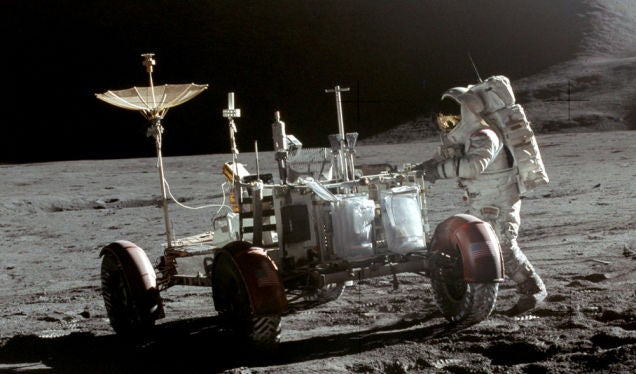
July 30, 1971 – The Apollo 15 mission deploys the first Lunar Rover on the Moon. Apollo 15 was the 9th manned mission launched by NASA as part of the Apollo program , and the 4th to land on the Moon. It was also the first of the so-called J missions , which featured extended stays of more than three days on the Lunar surface, with greater emphasis on scientific exploration. In order to cover more ground than was possible on foot, Apollo 15 deployed the first Lunar Roving Vehicle (LRV), a battery-powered rover that could carry two astronauts at speeds of 6 to 8 mph. Over the course of their stay on the Moon, astronauts David Scott and James Irwin covered a total distance of 17.25 miles in the Rover. The Rover, along with ones placed by Apollo 16 and Apollo 17 , remain on the Moon. (NASA photo)
!!! UNKNOWN CONTENT TYPE !!!
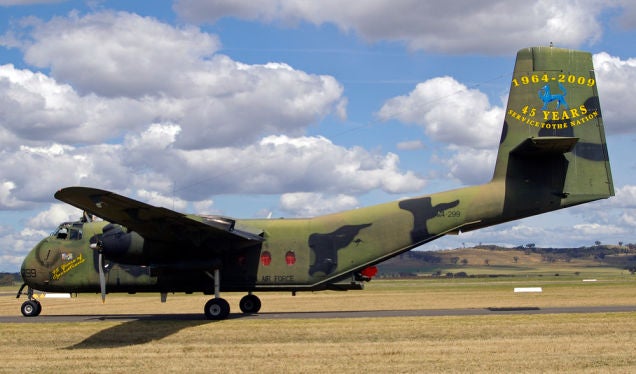
July 30, 1958 – The first flight of the de Havilland Canada DHC-4 Caribou,
a cargo aircraft designed for
short takeoff and landing
(STOL) to fulfill a requirement from the US Army for a tactical airlifter to supply frontline troops. Following the
DHC Beaver
and
DHC Otter
, the Caribou was the first aircraft designed by
de Havilland Canada
to have two engines, and it entered US Army service in 1961 where it was known as the C-7. Initially seeing service in Vietnam, the Caribou’s ability to operate from runways as short as 1,200 feet made it an ideal complement to the Air Force’s larger cargo airplanes. A total of 307 were produced, and the final Caribous were retired from military service by the Royal Australian Air Force in 2009.
(Photo by Bidgee via
Wikimedia Commons
)
!!! UNKNOWN CONTENT TYPE !!!

July 30, 1954 – The first flight of the Grumman F-11 Tiger,
a day fighter developed by Grumman for the US Navy began as an advanced development of the
Grumman F-9 Cougar
. Grumman eliminated the wing root air intakes and moved them forward to help reduce drag, made the wing thinner, moved the elevator down to the fuselage, and reshaped the fuselage to take advantage of the newly discovered
area rule
principle. The Tiger remained a work in progress throughout its career, and also earned the dubious distinction of becoming the first jet to shoot itself down when it overtook its own bullets in a dive during weapons testing. The Tiger’s operational career was relatively short, though it gained prominence when the fighter was selected by the Navy’s
Blue Angels
in 1957. A total of 200 Tigers were produced from 1954-1959, and it was retired from active service in 1961, though it served the Blue Angels until 1969.
(US Navy photo)
!!! UNKNOWN CONTENT TYPE !!!
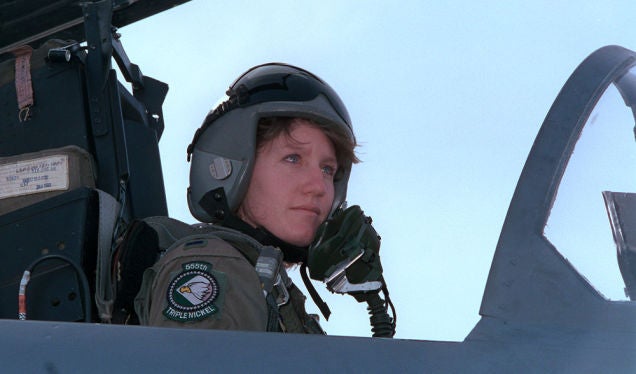
July 31, 1991 – The US Senate votes to allow women to fly combat aircraft.
Women were first allowed to fly US military aircraft in WWII as members of the
Women Airforce Service Pilots
(WASP), but they were limited to ferrying flights and were considered civilian pilots, receiving no military benefits. The first women military pilots received their wings in 1974 with the US Navy, and then in 1976 with the US Air Force, but they were still excluded from combat missions, even though they were flying cargo and liaison aircraft into war zones such as Panama, Grenada, and the Persian Gulf. Following the
Senate vote
,
Martha McSally
became the first American woman to fly a combat mission when she piloted a
Fairchild Republic A-1o Thunderbolt II
in support of
Operation Southern Watch
over Iraq in 1995.
(US Air Force photo)
!!! UNKNOWN CONTENT TYPE !!!
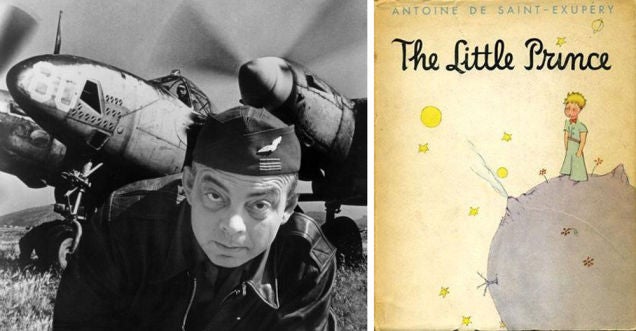
July 31, 1944 – The disappearance of Antoine de Saint-Exupéry.
Born on June 29, 1900,
Saint-Exupéry
was a French author and pilot who is best known for his book
Le Petit Prince
(
The Little Princ
e). Exupéry flew for the French Air Force in the early part WWII and, following the fall of France, he traveled to America to encourage the US to join the war before joining the
Free French Air Forces
in North Africa, even though his health was failing and he was beyond the age limit for service. Saint-Exupéry disappeared over the Mediterranean Sea while flying a Lockheed F-5B, the unarmed reconnaissance variant of the
Lockheed P-38 Lightning
, and while remains of a pilot were found, they were not confirmed to be his.
(Exupéry photo author unknown)
!!! UNKNOWN CONTENT TYPE !!!

July 31, 1941 – The first flight of the Lockheed Ventura, a medium bomber and maritime patrol aircraft developed from the Lockheed Model 18 Lodestar and designed to replace the Lockheed Hudson . The Ventura was initially flown by the RAF as a medium bomber, but it suffered high combat losses and was pulled from service in favor of the de Havilland Mosquito . Remaining Venturas were moved to maritime patrol missions. In US Army Air Corps service, it was known as the B-34 Lexington and was used primarily for training, though Army Venturas were subsequently transferred to the US Navy where they gained the designation PV-1, serving primarily in the Aleutian Islands of Alaska. (US Library of Congress photo)
!!! UNKNOWN CONTENT TYPE !!!
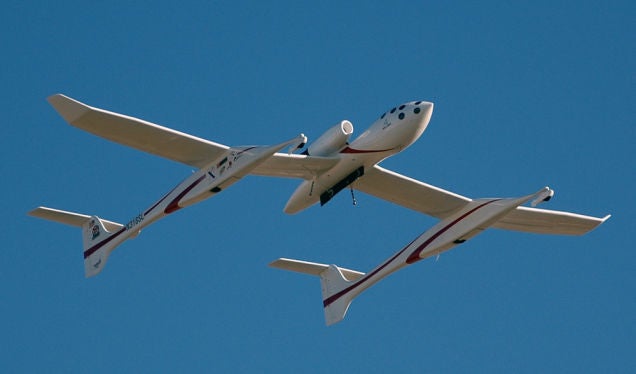
August 1, 2002 – The first flight of the Scaled Composites White Knight,
an aircraft designed to launch the
SpaceShipOne
experimental spacecraft in the first part of a program to take paying passengers into space. Designed by
Burt Rutan
, White Knight is powered by two
General Electric J85
turbojet engines and carried the SpaceShipOne to an altitude of 45,000 feet before releasing it to fly to space on its rocket motor. A total of 17 flights were made with SpaceShipOne before it was replaced by the larger and more powerful
White Knight Two
. Following the completion of the SpaceShipOne program, White Knight carried out drop tests of the
Boeing X-37
Orbital Test Vehicle. In July 2014, White Knight was retired to the
Flying Heritage Collection
in Everett, Washington.
(Photo by D Ramey Logan via
Wikimedia Commons
)
!!! UNKNOWN CONTENT TYPE !!!
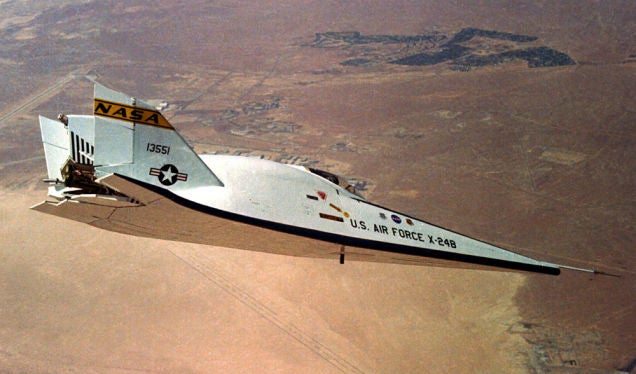
August 1, 1973 – The first flight of the Martin Marietta X-24B,
an experimental wingless aircraft developed jointly between the US Air Force and NASA to explore the design of
lifting body
aircraft. The X-24 was dropped from a
Boeing B-52 Stratofortress
, then powered by a rocket engine in flight before gliding to a landing. The lifting body research was carried out from 1963 to 1975 to investigate wingless vehicles that could land on Earth after flying in space, and data gained during these experiments was put to use in the design of the
Space Shuttle
. The X-24B made a total of 36 test flights before it was retired to the National Museum of the United States Air Force in Dayton, Ohio.
(NASA photo)
!!! UNKNOWN CONTENT TYPE !!!
!!! UNKNOWN CONTENT TYPE !!!
!!! UNKNOWN CONTENT TYPE !!!
!!! UNKNOWN CONTENT TYPE !!!
!!! UNKNOWN CONTENT TYPE !!!
!!! UNKNOWN CONTENT TYPE !!!
!!! UNKNOWN CONTENT TYPE !!!
If you enjoy these Aviation History posts, please let me know in the comments. And if you missed any of the past articles, you can find them all at Planelopnik History . You can also find more stories about aviation and aviators at Wingspan and Planes You’ve (Probably) Never Heard Of .
!!! UNKNOWN CONTENT TYPE !!!
 "benjrblant" (benjblant)
"benjrblant" (benjblant)
08/01/2017 at 12:44, STARS: 0
Women weren’t allowed to fly combat missions until 1991?! What?!
 "RamblinRover Luxury-Yacht" (ramblininexile)
"RamblinRover Luxury-Yacht" (ramblininexile)
08/01/2017 at 12:46, STARS: 0
Something which may be of interest:
http://www.warbirdregistry.org/pv1venturaregistry/pv1ventura-34645.html
I think the old computer game (‘92) Aces of the Pacific had Venturas in it, since one of the campaign lines you could follow was flying with the Marines out of the Solomons.
 "WilliamsSW" (williamssw)
"WilliamsSW" (williamssw)
08/01/2017 at 13:06, STARS: 1
Great stuff! And yeah, that Lockheed Ventura does look familiar...

08/01/2017 at 13:10, STARS: 1
IIRC, it would take only one volt at one amp to accidentally fire the older HVAR. I wonder how sensitive the Zuni are?
 "ttyymmnn" (ttyymmnn)
"ttyymmnn" (ttyymmnn)
08/01/2017 at 13:13, STARS: 0
You already sound more knowledgeable than me. I have no idea.
 "ttyymmnn" (ttyymmnn)
"ttyymmnn" (ttyymmnn)
08/01/2017 at 13:14, STARS: 0
Thanks!
 "ttyymmnn" (ttyymmnn)
"ttyymmnn" (ttyymmnn)
08/01/2017 at 13:15, STARS: 0
Fascinating. Thanks. Imagine how many other wrecks are still waiting to be found in the dense jungles of the Pacific.
 "ttyymmnn" (ttyymmnn)
"ttyymmnn" (ttyymmnn)
08/01/2017 at 13:16, STARS: 1
Yup. Thing is, they were still flying into combat zones and coming under fire. They just weren’t allowed to fire back.
 "Smallbear wants a modern Syclone, local Maple Leafs spammer" (smallbear94)
"Smallbear wants a modern Syclone, local Maple Leafs spammer" (smallbear94)
08/01/2017 at 13:23, STARS: 1
Which, frankly, requires more (metaphorical) balls.
 "facw" (facw)
"facw" (facw)
08/01/2017 at 13:26, STARS: 2
A Zuni also caused the Enterprise fire, but in that case, it was because it was exposed to hot exhaust and exploded, as opposed to an unintentional launch.


08/01/2017 at 13:27, STARS: 0
Well, to be fair, I heard that on Mythbusters, so YMMV.

 "ttyymmnn" (ttyymmnn)
"ttyymmnn" (ttyymmnn)
08/01/2017 at 13:41, STARS: 0
That one gets a lot less press.